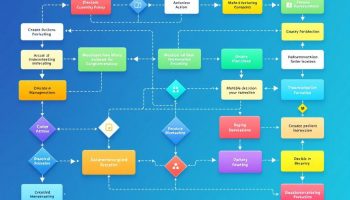
Understanding DMAIC Project Examples in Manufacturing
DMAIC project examples in manufacturing show how this structured problem-solving approach creates significant operational improvements across production environments. These examples demonstrate how Define, Measure, Analyze, Improve, and Control principles systematically tackle challenges from assembly line bottlenecks to quality issues in automotive, pharmaceutical, and other manufacturing sectors.
Business Impact and Implementation Value
DMAIC project examples in manufacturing deliver measurable business results through targeted process optimization and waste reduction. Companies using these methodologies report impressive returns on investment, including:
- Production throughput increases up to 25%
- Defect rate reductions from 5% to 0.5%
- Material waste decreases from 12% to 3%
- Equipment effectiveness improvements from 65% to 85%
- Prevention of costly product recalls
By applying this structured improvement methodology, manufacturing companies can transform operational challenges into competitive advantages that boost both profits and customer satisfaction.
DMAIC’s systematic approach helps you identify root causes of manufacturing problems rather than just treating symptoms. This leads to sustainable solutions that continue delivering value long after the initial project ends.
Discover 5 Real-World DMAIC Project Examples in Manufacturing to Boost Your Operations
In today’s competitive manufacturing landscape, the DMAIC (Define, Measure, Analyze, Improve, Control) methodology serves as an essential framework for driving operational excellence. This section highlights five impactful DMAIC project examples in manufacturing, showcasing how companies across various sectors have successfully tackled pressing challenges related to productivity, quality, and cost efficiencies. Each example will provide actionable insights into structured problem-solving processes that lead to significant improvements, whether it’s enhancing production throughput, reducing defect rates, or optimizing resource usage. By exploring these real-world applications, you can gain inspiration for implementing DMAIC strategies in your own manufacturing operations. Let’s dive into these case studies that illustrate the transformative power of data-driven decision-making in manufacturing environments.
“`html
1. Reducing Assembly Line Bottlenecks at an Automotive Plant
Manufacturing facilities often struggle with production delays that impact delivery schedules and customer satisfaction. This DMAIC project example in manufacturing addressed a critical issue at an automotive plant where 30% of production was delayed due to workstation bottlenecks. The implementation team utilized value stream mapping to identify workflow constraints, conducted detailed time studies, and applied statistical process control methods to monitor improvements.
Key implementation steps included:
- Identifying critical bottleneck workstations through data analysis
- Reorganizing workstation layouts to improve ergonomics
- Implementing standard work procedures
- Training operators on new methods
- Establishing continuous improvement protocols
The results were significant, delivering a 25% increase in production throughput and generating $2 million in annual savings. This successful application of DMAIC methodology demonstrates how structured problem-solving can transform manufacturing operations when properly implemented with appropriate stakeholder engagement.
“`
2. Minimizing Product Defects in Electronics Manufacturing
In electronics manufacturing, implementing DMAIC project methodologies can dramatically reduce defect rates in critical processes like printed circuit board assembly. This example demonstrates how a manufacturing facility tackled their 5% defect rate problem through systematic quality improvement.
The team started with a comprehensive Define phase, clearly identifying the PCB assembly defects costing the company millions annually. During the Measure phase, they collected baseline data showing exactly where in the production process defects occurred most frequently.
Analysis tools were essential to this DMAIC project example in manufacturing:
- Pareto analysis revealed that 80% of defects stemmed from just three process issues
- Fishbone diagrams helped identify root causes across materials, methods, machines, and manpower
- Design of experiments tested different combinations of process variables to find optimal settings
The Improve phase focused on implementing process modifications while managing dependencies between workstations. The team established new standardized work instructions and installed automated inspection systems.
For Control, they implemented statistical process control charts and created a project assurance framework to maintain gains. Results were impressive: defect rates dropped to just 0.5%, customer satisfaction improved by 40%, and warranty costs decreased significantly.
Expert Insight: To minimize product defects in electronics manufacturing, adopt the DMAIC methodology. Begin by identifying and measuring defects, then analyze root causes to implement targeted improvements. Standardize processes and use statistical controls to sustain gains, dramatically reducing defect rates and enhancing customer satisfaction and cost-effectiveness.
3. Optimizing Material Usage in Plastic Injection Molding
In this impactful DMAIC project example in manufacturing, a plastics company tackled excessive waste in their injection molding process. Facing 12% raw material waste, the team implemented a structured improvement approach using DMAIC methodology.
The Define phase identified material waste as the primary cost driver, while the Measure phase quantified current performance through statistical sampling. During Analysis, the team used process capability analysis to identify key variables affecting waste generation, revealing inconsistent temperature control and mold design flaws as root causes.
For the Improve phase, they implemented several strategies:
- Redesigned mold gates to minimize flash and overflow
- Created standardized temperature control procedures
- Applied 5S methodology to organize the production floor
- Developed regression testing protocols for new material batches
The Control phase established ongoing monitoring processes and visual management systems. This comprehensive DMAIC project reduced waste from 12% to just 3%, generating $500K in annual material cost savings while improving product consistency. The team also documented procedures for managing dependencies between material properties and machine settings.
Expert Insight: To optimize material usage in plastic injection molding, leverage the DMAIC methodology to identify waste sources and implement targeted improvements. Focus on enhancing mold design and temperature control, establishing standardized procedures, and incorporating ongoing monitoring. These strategies can significantly reduce waste, lead to substantial cost savings, and improve product quality.
4. Improving Equipment Uptime in Food Processing
In this notable DMAIC project example in manufacturing, a food processing plant faced significant equipment reliability challenges with just 65% Overall Equipment Effectiveness (OEE). The implementation team began by collecting comprehensive downtime data across production lines to identify critical failure patterns.
Using structured DMAIC methodology, they first defined the most problematic equipment and quantified the impact on production. During the measure phase, they tracked equipment failures, categorizing them by frequency and duration to pinpoint root causes.
The analysis phase revealed several key issues:
- Inconsistent maintenance procedures
- Lack of operator training on equipment care
- No standardized preventive maintenance schedule
- Inadequate spare parts inventory management
The improvement phase included implementing a preventive maintenance scheduling system, creating standardized operating procedures for equipment, and developing comprehensive operator training programs. The team also established clear project milestones to track progress throughout implementation.
By carefully controlling these changes and monitoring results, the plant increased OEE to 85% and reduced maintenance costs by 30%, demonstrating how DMAIC project examples in manufacturing can deliver substantial operational improvements.
Expert Insight: To improve equipment uptime in food processing, implement a structured preventive maintenance schedule and standard operating procedures. Enhance operator training to ensure proper equipment care and establish a robust spare parts inventory management system. These measures can significantly boost Overall Equipment Effectiveness and reduce maintenance costs.
5. Standardizing Quality Control in Pharmaceutical Packaging
When implementing DMAIC project examples in manufacturing, pharmaceutical packaging quality control presents unique challenges. A major manufacturer faced inconsistent inspection procedures that led to costly recalls and damaged brand reputation.
The DMAIC methodology provided a structured approach to resolve these issues:
- Define: The team identified critical quality parameters and established clear inspection criteria
- Measure: They collected baseline data on defect rates and variability in inspection results
- Analyze: Root cause analysis revealed training inconsistencies and procedural gaps
- Improve: Implementation focused on three key areas:
- Standardized inspection procedures with detailed visual aids
- Control charts to monitor process variation in real-time
- Mistake-proofing (poka-yoke) devices to prevent common errors
The results were remarkable, with a 90% reduction in packaging defects. Most importantly, the company achieved zero recalls over a 12-month period, saving millions in potential recall costs and protecting consumer safety.
By applying continuous improvement principles throughout the project, the team created a sustainable quality system that maintained consistent performance long after implementation.
Expert Insight: To ensure effective quality control in pharmaceutical packaging, standardize inspection procedures using visual aids and control charts. Implement mistake-proofing devices to minimize errors and enhance training consistency. This structured approach not only reduces defects significantly but also protects brand reputation and consumer safety over time.
DMAIC project examples in manufacturing showcase how this structured problem-solving approach delivers measurable improvements in production environments across various industries. These five case studies demonstrate successful implementations in automotive assembly, electronics manufacturing, plastic injection molding, food processing, and pharmaceutical packaging, with each delivering significant operational and financial benefits through systematic application of the Define, Measure, Analyze, Improve, and Control methodology.
DMAIC project examples in manufacturing are essential for modern enterprises seeking to remain competitive in increasingly demanding markets where efficiency and quality are paramount. By implementing these structured improvement methodologies, manufacturing organizations can systematically eliminate bottlenecks, reduce defects, optimize material usage, improve equipment uptime, and standardize quality control—ultimately translating to millions in cost savings, enhanced customer satisfaction, and sustainable operational excellence that drives long-term business growth.
Conclusion
DMAIC methodology in manufacturing environments offers transformative results when properly implemented, as evidenced by the five case studies showcasing significant improvements across diverse manufacturing sectors. From reducing assembly line bottlenecks and minimizing defects to optimizing material usage, improving equipment uptime, and standardizing quality control, these examples demonstrate how systematic problem-solving can deliver substantial financial benefits while enhancing operational efficiency.
Actionable Steps
- Begin by clearly defining your manufacturing challenge and establishing measurable success criteria before implementing any DMAIC project.
- Collect comprehensive baseline data to accurately measure current performance and identify root causes of inefficiency.
- Implement standardized work procedures and training programs to ensure consistent application of improvements.
- Establish robust control mechanisms including statistical process control and visual management systems to maintain gains.
- Document successful methodologies to create a knowledge base for future continuous improvement initiatives.






